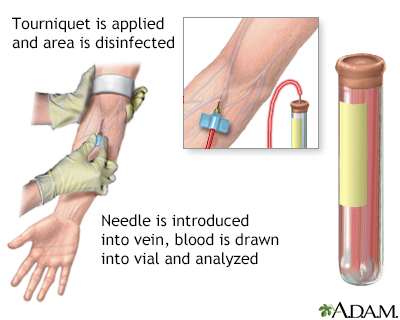Ceruloplasmin blood test
CP - serum; Copper - ceruloplasmin
The ceruloplasmin test measures the level of the copper-containing protein ceruloplasmin in the blood.
Images

I Would Like to Learn About:
How the Test is Performed
A blood sample is needed.
How to Prepare for the Test
No special preparation is needed.
How the Test will Feel
When the needle is inserted to draw blood, some people feel moderate pain. Others feel only a prick or stinging. Afterward, there may be some throbbing or a slight bruise. This soon goes away.
Why the Test is Performed
Ceruloplasmin is made in the liver. Ceruloplasmin stores and transports copper in the blood to parts of the body that need it.
Your health care provider may order this test if you have signs or symptoms of a copper metabolism or copper storage disorder.
Normal Results
The normal range for adults is 20 to 40 mg/dL.
Normal value ranges may vary slightly among different labs. Some labs use different measurements or may test different samples. Talk to your provider about the meaning of your specific test results.
What Abnormal Results Mean
A lower-than-normal ceruloplasmin level may be due to:
- Long-term (chronic) liver disease
- Problem absorbing nutrients from food (intestinal malabsorption)
- Malnutrition
- Disorder in which cells in the body can absorb copper, but are unable to release it (Menkes syndrome)
- Group of disorders that damage the kidneys (nephrotic syndrome)
- Inherited disorder in which there is too much copper in the body's tissues (Wilson disease)
A higher-than-normal ceruloplasmin level may be due to:
- Acute and chronic infections
- Cancer (breast or lymphoma)
- Heart disease, including heart attack
- Overactive thyroid
- Pregnancy
- Rheumatoid arthritis
- Use of birth control pills
Risks
There is little risk in having your blood taken. Veins and arteries vary in size from one person to another, and from one side of the body to the other. Obtaining a blood sample from some people may be more difficult than from others.
Other risks associated with having blood drawn are slight, but may include:
- Excessive bleeding
- Fainting or feeling lightheaded
- Multiple punctures to locate veins
- Hematoma (blood accumulating under the skin)
- Infection (a slight risk any time the skin is broken)
Related Information
MetabolismProtein in diet
Menkes disease
Wilson disease
Hodgkin lymphoma
Acute
Chronic
Rheumatoid arthritis
References
Koppel BS, Weimer LH, Daras M. Nutritional and alcohol-related neurologic disorders. In: Goldman L, Cooney KA, eds. Goldman-Cecil Medicine. 27th ed. Philadelphia, PA: Elsevier; 2024:chap 384.
McPherson RA. Specific proteins. In: McPherson RA, Pincus MR, eds. Henry's Clinical Diagnosis and Management by Laboratory Methods. 24th ed. Philadelphia, PA: Elsevier; 2022:chap 20.
Schilsky ML. Wilson disease. In: Goldman L, Cooney KA, eds. Goldman-Cecil Medicine. 27th ed. Philadelphia, PA: Elsevier; 2024:chap 195.
BACK TO TOPReview Date: 2/13/2025
Reviewed By: Jacob Berman, MD, MPH, Clinical Assistant Professor of Medicine, Division of General Internal Medicine, University of Washington School of Medicine, Seattle, WA. Also reviewed by David C. Dugdale, MD, Medical Director, Brenda Conaway, Editorial Director, and the A.D.A.M. Editorial team.

Health Content Provider
06/01/2025
|
A.D.A.M., Inc. is accredited by URAC, for Health Content Provider (www.urac.org). URAC's accreditation program is an independent audit to verify that A.D.A.M. follows rigorous standards of quality and accountability. A.D.A.M. is among the first to achieve this important distinction for online health information and services. Learn more about A.D.A.M.'s editorial policy, editorial process and privacy policy. A.D.A.M. is also a founding member of Hi-Ethics. This site complied with the HONcode standard for trustworthy health information from 1995 to 2022, after which HON (Health On the Net, a not-for-profit organization that promoted transparent and reliable health information online) was discontinued. |
The information provided herein should not be used during any medical emergency or for the diagnosis or treatment of any medical condition. A licensed medical professional should be consulted for diagnosis and treatment of any and all medical conditions. Links to other sites are provided for information only -- they do not constitute endorsements of those other sites. © 1997- 2025 A.D.A.M., a business unit of Ebix, Inc. Any duplication or distribution of the information contained herein is strictly prohibited.
